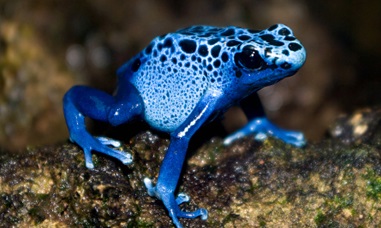Blue poison dart frog
Dendrobates tinctorius azureus

A late discovery
Blue poison dart frogs are found in only a few isolated areas of rainforest in Suriname and northern Brazil, so were only discovered in 1969. They are diurnal, which means they are active during the day. They live under rocks and moss near streams, but can sometimes be seen high up in the surrounding trees.
Poisonous skin
Poison dart frogs store a natural poison in their skin that can paralyse or even kill predators. These poisons are not created by the frog itself but are due to their diet of highly poisonous ants in the wild. The bright colouration of these frogs serves as warning to potential predators.
Indigenous cultures, such as the Chocó people of Colombia, have used these frogs’ poison for centuries to coat the tip of their blow darts before hunting — a tradition that inspired the frogs’ common name.
Did you know?
Like most other amphibians, the blue dart frog starts life as an egg. This then develops into a tadpole which is carried by either the mother or father to a body of water within which it can develop. The process of development into a frog is known as metamorphosis and is one of nature’s true marvels.
Quick facts
| Scientific name Dendrobates tinctorius azureus | Native to Suriname and Brazil | Rainforest layer Forest floor |
| Diet Insects | Size Maximum length 6cm | Weight 5g |
| Lifespan 6 years | IUCN conservation status Not evaluated – learn more | CITES Appendix ii Trade restricted – learn more |
Concerns
Poison dart frogs are threatened as a result of collection for the pet trade, habitat destruction and a deadly fungus known as ‘Chytrid’ which is wiping out populations of amphibians around the world. The ‘azureus’ is believed to be one of the most threatened of all poison dart frogs in Central and South America, occurring only in a small area of Suriname and an even smaller area of northern Brazil.
